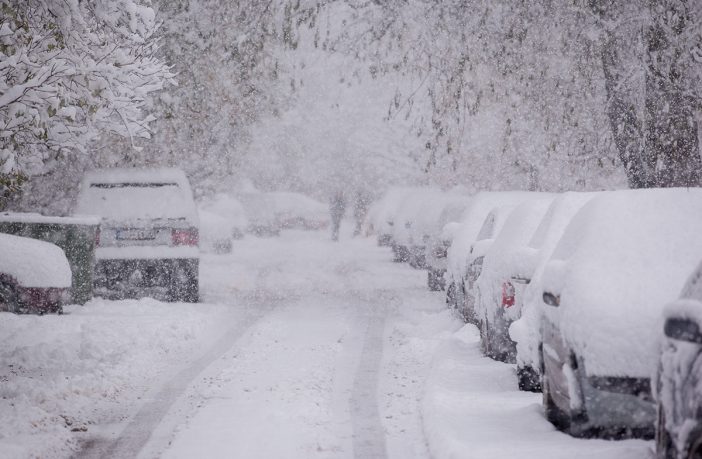Governor Kathy Hochul today directed State agencies to prepare emergency response assets in advance of a large coastal weather system predicted to bring heavy, wet snow to much of the state beginning late Saturday and continuing into Sunday for some places. While there is still uncertainty regarding snow totals and exactly where snow will transition to rain, current forecasts project 3 to 8 inches of snow throughout parts of the Southern Tier, Mid-Hudson, Capital, Mohawk Valley, Central New York, and the Finger Lakes Regions, with a wintry mix of snow and rain in the New York City Metro Area. As these types of conditions can cause power outages and hazardous travel, Governor Hochul is urging New Yorkers to begin preparing their households as well, and to closely monitor their local forecasts in the coming days as forecast details become clearer.
“We are watching an impending coastal weather system moving in this weekend, and in preparation I’ve directed State agencies to mobilize emergency response assets,” Governor Hochul said. “We anticipate heavy, wet snowfall across various regions, potentially causing power outages and hazardous travel. I urge New Yorkers to be vigilant. Prepare your households, monitor local forecasts, and plan for the next couple of days as the forecast comes into clearer view. Together, we’ll weather the storm.”
For a complete listing of weather alerts and forecasts, visit the National Weather Service website at https://alerts.weather.gov. New Yorkers are also encouraged to sign up for emergency alerts by subscribing to NY Alert at https://alert.ny.gov, a free service providing critical emergency information to your cell phone or computer.
Agency Activities
New York State Division of Homeland Security and Emergency Services
The Division is actively monitoring the weather forecast and coordinating the State’s response to the weather event. Office of Emergency Management staff are in contact with local counterparts and are prepared to facilitate requests for assistance. The Division is prepared to deploy emergency response assets and shelter supplies from the State’s stockpiles.
New York State Department of Transportation
The State Department of Transportation is monitoring weather conditions and prepared to respond with 3,692 supervisors and operators available statewide. All residency locations will remain staffed for 24/7 operation throughout the duration of the event and priority cleanup operations. All available snow and ice equipment is ready to deploy. Fleet mechanics in affected areas will be staffing all main residency locations 24/7 to perform repairs and keep trucks on the road.
Statewide equipment numbers are as follows:
- 1,617 large plow trucks
- 149 medium duty plows
- 52 tow plows
- 343 large loaders
- 36 snow blowers
For real-time travel information, motorists should call 511 or visit https://www.511ny.org or the mobile site at m.511ny.org, New York State’s official traffic and travel information source.
Thruway Authority
Thruway Authority staff is closely monitoring the weather forecast and ready to respond with 700 operators and supervisors available. Statewide equipment numbers and resources are listed below:
- 368 large and medium duty plow trucks
- 11 tow plows
- 67 loaders
- More than 127,000 tons of salt on hand
Variable Message Signs and social media are utilized to alert motorists of winter weather conditions on the Thruway.
The Thruway Authority encourages motorists to download its mobile app which is available for free on iPhone and Android devices. The app provides motorists direct access to real-time traffic information, live traffic cameras, and navigation assistance while on the go. Motorists can also sign up for TRANSalert e-mails and follow @ThruwayTraffic on X for the latest traffic conditions along the Thruway.
New York State Department of Public Service
Utility companies regulated by the Department of Public Service have approximately 5,500 workers available statewide to engage in repair and restoration efforts for the winter weather system. DPS staff will track utilities’ work throughout the event and ensure utility companies shift appropriate staffing to regions that experience the greatest impact. If your service is interrupted, visit the DPS Utility Service Interruptions website for tips.
New York State Police
State Police are monitoring weather conditions and are prepared to deploy additional Troopers as needed. All State Police four-wheel drive and specialized vehicles, including snowmobiles and utility terrain vehicles, are staged and ready for immediate response, and all emergency power and communications equipment has been tested.
New York State Department of Environmental Conservation
DEC Emergency Management staff, Environmental Conservation Police Officers, Forest Rangers, and regional staff are on alert and monitoring the developing situation and weather forecasts. All available assets are positioned to assist with any emergency response.
DEC reminds those responsible for the large-scale removal and disposal of snow to follow best management practices to help prevent flooding and reduce the potential for pollutants like salt, sand, oils, trash, and other debris in snow from affecting water quality. Disposal of snow in local creeks and streams can create ice dams which may cause flooding in nearby areas. Public and private snow removal operators should be aware of these safety issues during and after winter storms. Additional information is available at https://www.dec.ny.gov/docs/water_pdf/togs5111new.pdf.
New York State Office of Parks, Recreation and Historic Preservation
New York State Park Police and park personnel are on alert and closely monitoring weather conditions and impacts. Response equipment is being fueled, tested, and prepared for storm response use. Park visitors should check https://parks.ny.gov/ or call their local park office for the latest updates regarding park hours, openings, and closings.
Metropolitan Transportation Authority
The MTA is closely monitoring weather conditions to ensure safe, reliable service. MTA employees will be poised to spread salt, clear platforms and stairs where ice exists, and keep signals, switches, and third rail operating, remove any downed trees that may fall across tracks, and attend to any weather-related challenges during the storm. MTA Bridges and Tunnels is advising motorists to use caution when driving on icy roadways and drive at reduced speeds.
Customers are encouraged to check https://new.mta.info for the latest service updates, and to use caution while navigating the system. Customers should also sign up for real-time service alerts via text or email. These alerts are also available via the MTA’s apps: MYmta and TrainTime.
Port Authority
The Port Authority monitors weather conditions across all its facilities. In the event of severe weather conditions, the agency issues regular travel alerts and updates as needed. For the latest information about Port Authority facilities, please check social media, sign up for PA alerts or download one of the PA mobile apps, including RidePATH, which provides real-time updates and alerts for PATH service.
Safety Tips
Travel
Some of the most important tips for safe driving include:
- Do not drive unless necessary.
- If you must travel, make sure your car is stocked with survival gear like blankets, a shovel, flashlight and extra batteries, extra warm clothing, set of tire chains, battery booster cables, quick energy foods and brightly colored cloth to use as a distress flag.
- If you have a cell phone or other communications device such as a two-way radio available for your use, keep the battery charged and keep it with you whenever traveling. If you should become stranded, you will be able to call for help, advising rescuers of your location.
- The leading cause of death and injuries during winter storms is transportation accidents. Before getting behind the wheel, make sure that your vehicle is clear of ice and snow; good vision is key to good driving. Plan your stops and keep more distance between cars. Be extra alert and remember that snowdrifts can hide smaller children. Always match your speed to the road and weather conditions.
- It is important for motorists on all roads to note that snowplows travel at speeds up to 35 mph, which in many cases is lower than the posted speed limit, to ensure that salt being dispersed stays in the driving lanes and does not scatter off the roadways. Oftentimes on interstate highways, snowplows will operate side by side, as this is the most efficient and safe way to clear several lanes at one time.
- Motorists and pedestrians should also keep in mind that snowplow drivers have limited lines of sight, and the size and weight of snowplows can make it very difficult to maneuver and stop quickly. Snow blowing from behind the plow can severely reduce visibility or cause whiteout conditions. Motorists should not attempt to pass snowplows or follow too closely. The safest place for motorists to drive is well behind the snowplows where the roadway is clear and salted. Never attempt to pass a snowplow while its operating.
Power Outages
- Check with your utility to determine area repair schedules.
- Turn off or unplug lights and appliances to prevent a circuit overload when service is restored; leave one light on to indicate when power has been restored.
- If heat goes out during a winter storm, keep warm by closing off rooms you do not need.
To Report an Electric Outage, Call:
- Central Hudson: 800-527-2714
- Con Edison: 800-752-6633
- National Grid: 800-867-5222
- NYSEG: 800-572-1131
- O&R: 877-434-4100
- PSEG-LI: 800-490-0075
- RG&E: 800-743-1701
Heating Safety
- Use only safe sources of alternative heat such as a fireplace, small well-vented wood or coal stove or portable space heaters.
- When using alternative heat sources such as a fireplace, woodstove, etc. always make sure you have proper ventilation. Always follow manufacturer’s instructions.
- Keep curtains, towels, and potholders away from hot surfaces.
- Have a fire extinguisher and smoke detectors and make sure they work.
- If you use kerosene heaters to supplement your regular heating fuel, or as an emergency source of heat, follow these safety tips:
- Follow the manufacturers’ instructions.
- Use only the correct fuel for your unit.
- Refuel outdoors only and only when the unit is cool.
- Keep the heater at least three feet away from furniture and other flammable objects.
- When using the heater, use fire safeguards and ventilate properly.
For more winter safety tips, visit https://dhses.ny.gov/safety. For all non-emergency service needs in New York State before, during or after a storm, call 211 or visit 211nys.org.
About the Division of Homeland Security and Emergency Services
The Division of Homeland Security and Emergency Services (DHSES) provides leadership, coordination, and support to prevent, protect against, prepare for, respond to, recover from, and mitigate disasters and other emergencies. For more information, follow @NYSDHSES on Facebook, Instagram, and X (formerly known as Twitter) or visit dhses.ny.gov.














